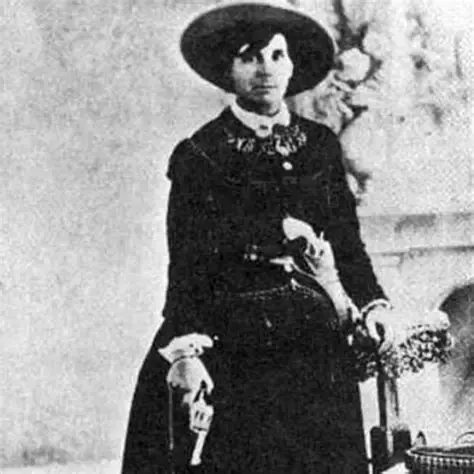Cold Case Files?: Historians link wandering outlaw to the 1889 ambush and slaying of outlaw queen Belle Starr
- Dennis McCaslin

- Jul 9
- 4 min read



Born on November 11, 1855, in Union (Edgefield) County, South Carolina, Edgar J. “E.J.” Watson entered a world shadowed by hardship. His father, Elijah “Lige” Watson--nicknamed “Ring Eye” for a jagged scar circling his eye--was a volatile figure whose unpredictable temper and brutal hand defined young Edgar’s early years.
Growing up under such oppression, Edgar and his sister found solace only when their mother, weary of the abuse, fled with them to Fort White, Florida in a desperate bid for safety.

This relocation marked the beginning of Watson’s tumultuous journey, one that would see him transform from a battered child into a figure of infamy.
By the 1880s, Watson’s life took a darker turn as he fled legal troubles, drifting into the Indian Territory--now eastern Oklahoma. There, he worked as a sharecropper on land owned by the infamous outlaw queen, Belle Starr.
Known for her lawless charm, Starr soon uncovered Watson’s past as a fugitive wanted for murder in Florida. Unwilling to harbor such a liability, she evicted him from her property, a decision that may have sealed her fate.

On February 3, 1889, Belle was ambushed and fatally shot near Eufaula. Watson, found near the scene with boot tracks matching those near the crime, was arrested.
Yet, with no eyewitnesses and flimsy evidence, he was acquitted. Rumors swirled that Belle had threatened to expose his earlier Florida crimes unless he left her land, adding a layer of intrigue to the unsolved murder.
Other suspects, including her son Ed Reed and Cherokee lover Jim July, were considered, but the case remains a historical enigma.

In 1891, Watson returned to southwestern Florida, establishing a sugarcane plantation on 40 acres at Chatham Bend, 17 miles south of Chokoloskee. The plantation became a hub for transient laborers--drifters, fishermen, and ranchers--whom Watson lured with promises of work.
Yet, whispers of treachery followed him. Locals alleged that when these workers demanded wages, Watson turned to murder, burying their bodies in shallow graves or discarding them in nearby waterways. Among the rumored victims were Hannah Smith and members of the Tucker family, who dared to challenge his iron-fisted rule.
Over the years, the discovery of human remains--skulls and skeletons--around his former homestead fueled the chilling legend of Watson as a cold-blooded killer.

The region’s fate shifted in mid-October 1910 when a ferocious hurricane ravaged the area, leaving destruction in its wake. Days later, on October 24, Watson sailed to Smallwood’s Store on Chokoloskee Island.
Exhausted by his reign of terror, a mob confronted him. In a dramatic standoff, Watson’s shotgun misfired due to faulty shells, and as he reached for a revolver, the townspeople opened fire. Riddled with approximately 33 bullets, his body fell, ending his notorious life. The mob dragged his corpse to Rabbit Key, burying him face down--a grim symbol of his perceived damnation.
About three weeks later, his son-in-law, Walter Langford, exhumed the body and reinterred it in the Fort Myers Cemetery, offering a semblance of closure to a fractured family.

Today, E.J. Watson rests in Fort Myers Cemetery, Lee County, Florida. Initially interred on Rabbit Key, his remains were later moved by family to a marked grave that still stands as a testament to his complex legacy.
Watson’s personal life was as tangled as his criminal history. He married at least three times, fathering seven children: four with his first wife, including Lucius Hampton, and three with Edna Katie Bethea, including Ruby and Hampton.
Lucius Hampton Watson lived to 81, passing in 1970, and was buried near his father, linking their stories across generations.

Watson’s marital life reflected the chaos of his existence. His first wife, whose name remains less documented but is believed to be from his early years in South Carolina, bore him four children: Lucius Hampton, Minnie Lee, Eddie, and Ida. Lucius, the eldest, would later become a prominent figure, living until 1970 and inheriting some of his father’s attribues.
.Minnie Lee and Eddie followed varied paths, with little recorded of their lives beyond the shadow of their father’s reputation, while Ida’s story fades into obscurity, possibly due to the family’s dispersal.
His second marriage, details of which are sparse, ended amid his flight from legal troubles, leaving little trace of his wife or any additional offspring.
His third and most notable marriage was to Edna Katie Bethea, a woman from the Fort Myers area, whom he wed after settling in Florida. Together, they had three children: Ruby, Hampton, and a third child whose name is less commonly cited, possibly due to early mortality or family discretion.
Edna, a steadfast presence, remained with Watson through his plantation years, raising their children amid the rumors of his dark deeds. Ruby grew to adulthood, later recounting tales of her father’s complex character, while Hampton, named perhaps in honor of his half-brother, carried the family name forward, though his life remained less publicized.
The Watson children were raised in an environment marked by their father’s notoriety. Lucius, in particular, sought to distance himself from the criminal legacy, establishing a quieter life in Fort Myers. The younger children, influenced by Edna’s efforts to shield them, navigated a childhood punctuated by the community’s suspicion and the occasional disappearance of their father’s workers.
This family dynamic added a human layer to Watson’s story, revealing a man who, despite his violence, was a father and husband whose actions left an indelible mark on his descendants.
Edgar J. Watson’s life was a tapestry of violence, flight, and retribution, leaving behind a legacy that continues to captivate historians and locals alike. From the scarred fields of South Carolina to the blood-soaked soils of Florida, his tale remains a stark reminder of the lawless frontier that shaped the American South.



